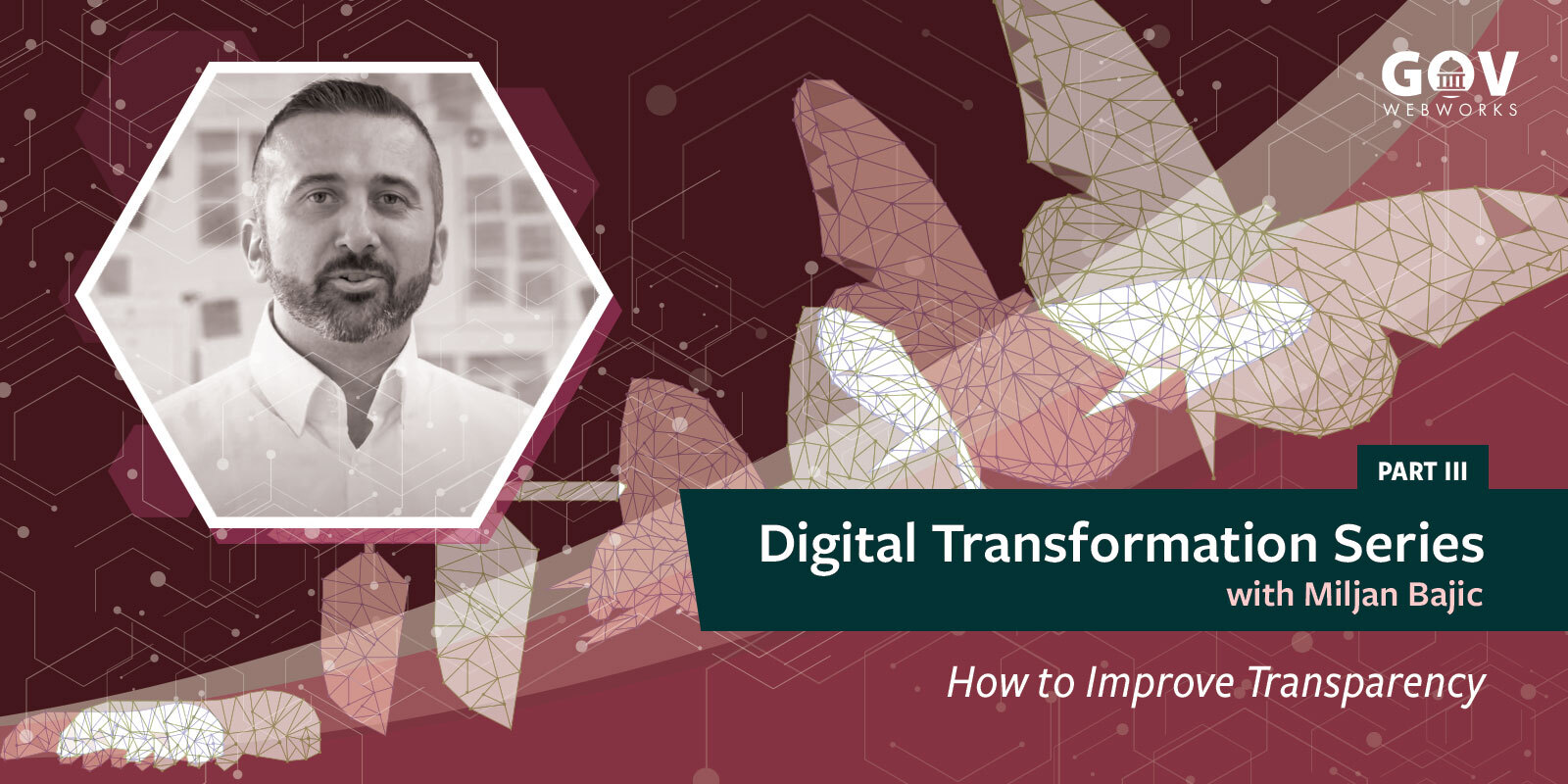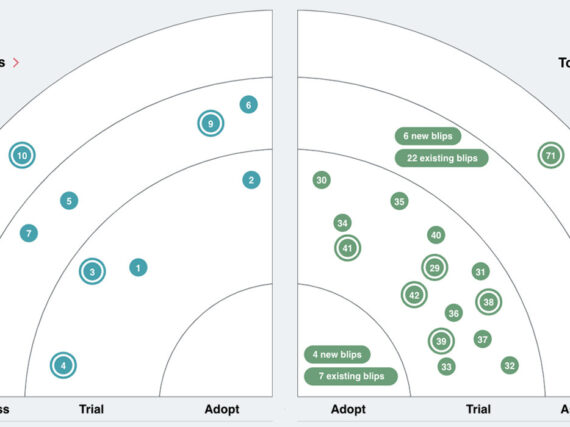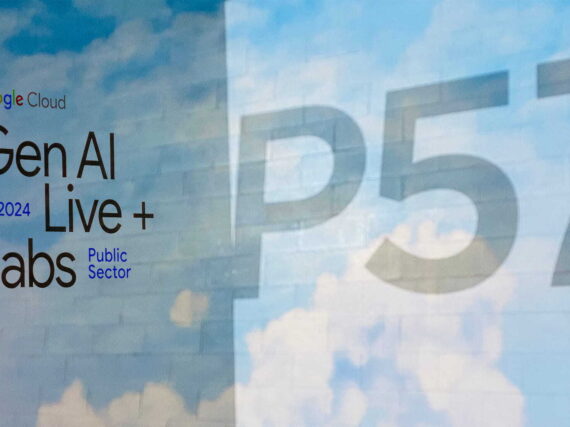Transparency is becoming increasingly important for government agencies in response to internal and external pressure to measure effectiveness and efficiency. We have found that a fundamental part of achieving transparency is organizational change. In order to successfully operate in a transparent manner, traditionally rigid organizations need to adopt new ways of communicating and adjust their expectations of accountability and ownership.
“Many leaders are rethinking the design and structure of their organizations,” our enterprise Agile expert Miljan Bajic says. “They recognize that organization design can be a powerful way to boost performance.”
Previous articles in our Digital Transformation series have examined the different aspects of digital transformation, what it means for the public sector, and how an iterative approach can be employed to make forward progress, even when funding is limited. In this post, we’ll look at how transformation can be structured to increase visibility and transparency, both internally and externally, and how to employ user feedback and short milestones in the process.
What does transparent transformation look like?
An example of a transparent process would be slowly rolling out software enhancements incrementally, and receiving feedback from users after every release. By working in smaller incremental releases, the chances for significant delays or cost overruns are diminished, and those providing feedback have the opportunity to shape the final product to best suit their needs. The opportunity to provide feedback also generates ownership and buy-in from users, mitigating the risk of failure.
Many departments are already using some form of Agile framework in their transformation process to provide them with more visibility into the status of their projects. This framework includes constant and clear communication, not just from the team developing the code, but also from the business stakeholders and leadership. While this can mean a long-term investment of time and commitment from key stakeholders, the results are usually worth the effort. Feedback is heard and enveloped into the end product. And because there is constant communication, there is more investment from the team members. Approaches including a product backlog and rituals such as sprint reviews enable key stakeholders to have constant visibility into the project as it progresses.
Ultimately, transparent organizations become different from traditional organizations, which may cause discomfort for some agencies at first. Such a transformation deeply alters the culture, values, and inner workings of an organization. However, a shift from the usual hierarchical and often siloed structures found in the public sector allows all parts of a department to meaningfully contribute to positive change.
Making transparency part of the culture
Moving beyond large-scale system replacement to a more nimble, incremental approach requires the re-examination of organizational structures. Increasing the visibility into the status of the transformation process means key constituents (both internal and external) gain greater input into the changes being enacted, resulting in fewer surprises for all concerned.
“Organizational culture is a reflection of its current and past structures and the mindset of its leaders,” notes Miljan. As such, certain management frameworks lend themselves to transparency more than others. As we’ve said in How To Provide Value on a Budget, the framework should fit the desired outcomes, rather than the other way around. The framework should also align with the organization’s cultural objectives so that it resonates for its staff.
Change can not occur without top-down investment and support. And this can’t happen if key stakeholders can’t see what’s going on, or don’t understand the process. This is why Miljan stresses the importance of everyone participating in training, including leadership. “That way everyone is speaking the same language and understands who is responsible for what.”
User-centered transparency
Another aspect of transparency that we’ve alluded to is the practice of soliciting constant feedback from users during the transformation process. This feedback might come in the form of input from internal end-users of a new case management system. It could also include external surveys and focus groups that seek out input from citizens on a new web portal or mobile app. Again, user feedback may cause initial discomfort and feelings of vulnerability, as work-in-progress software is laid bare for external users to poke holes in. Yet this vulnerability is a key ingredient in creating trust with users, and it is exactly how great software gets built. The emphasis here is not on moments of great inspiration, but by grinding through concepts with users, receiving honest feedback, and using it to refine the product or platform.
At GovWebworks, we always try to inject some level user input into our projects, with the benefit being that it scales easily to fit the needs of the project. Efforts can range from a complete ethnographic study to surveying the office for people’s opinions. Any amount of external user input beats developing in a vacuum, and in many cases there are readily available volunteers who are only too happy to share their opinions.
For the ultimate example of transparent user testing, consider the City of Boston who partnered with IDEO to redevelop Boston.gov. The new site was rolled out in sections and trialed over a period of six months, with each new update directly soliciting feedback from site visitors. In many cases sections of the site were significantly retooled based on user input. The final site has received national acclaim, including a Webby Honoree award in 2017.
Transparency around milestones
On most projects, people want to know the same things:
- How far along are we?
- How much is left?
- When will we be done?
The bigger the project, the greater the degree of uncertainty there can be in answering any of these questions. Traditional waterfall projects were notorious for going off schedule (and over budget), as noted by Governing, simply because of the number of unknowns that inevitably reveal themselves along the way.
Nowadays, smart agencies try to maximize visibility into project progress by keeping milestones as short as possible. In many cases, this is not only a practical approach but is mandated by those providing the funding. Without proper oversight, grant recipients have a habit of having little to show for their investment, even after years of funding. So many federal and philanthropic grant providers set clear checkpoints throughout the life of the grant that recipients must meet in order to secure further funding. In order to meet these checkpoints, recipients need clear visibility into project progress so they can adjust as needed to stay on track.
For example, the initial phases of the CareerForce project that we’re working on with the Minnesota Department of Employment and Economic Development (DEED) was funded by a Workforce Innovation Fund grant from the U.S. Department of Labor. In this case, the DoL assigned independent oversight to ensure that important milestones were being met according to the grant schedule. This checkpoint requirement aligned well with the iterative delivery approach we had recommended. With scope rapidly evolving, we focused on delivering the elements that were known, and re-adjusted the scope as necessary every two-three months.
This idea of a “Product Increment” (which originated with the Scale Agile Framework – SAFe) is one that also served us well when working with the State of Idaho (IDHW) on their integrated eligibility platform, a project we have supported with an Agile framework since 2011. Sometimes working in a purely Agile environment can make it difficult to see the forest for the trees, and so pausing every quarter to plan out the next major milestones can help keep larger objectives in sight. For both IDHW and DEED, we worked with our clients to make sure milestones were always met and the platforms launched according to a predictable release schedule.
In summary: Visibility drives accountability
In this article, we’ve talked about the ways in which agencies can increase internal visibility in their day-to-day progress as well as share progress externally in the interest of receiving user feedback. All of this ushers in a new level of transparency which challenges expectations of government performance. This may cause discomfort for some, but it also helps drive efficiency and promotes an understanding of how agencies strive to meet their goals. While the outcome may not be perfect at first, the scrutiny drives transparency and accountability.
“Predictability requires stability,” as Miljan says. “That’s why organizational structures that have dedicated teams, customer focus, shorter planning cycles, and high levels of transparency are more successful.”
As we have seen, digital transformation is about applying new technologies to do things in a different way. Because digital transformation can be very involved, it is best to find a good partner to help guide you through this process. If you would like to enlist a consultant for your digital transformation efforts, please reach out to us.
Learn more
- IDEO’s Human Centered Design Process: How to Make Things People Love | UserTesting Blog, via User Testing
- What is SAFe? The Scaled Agile Framework explained, via CIO
- Design Thinking – Scaled Agile Framework, via Scaled Agile
- Playback: AGL Panel Discussion on Digital Transformation during COVID-19 – AGL Association, via AGL







